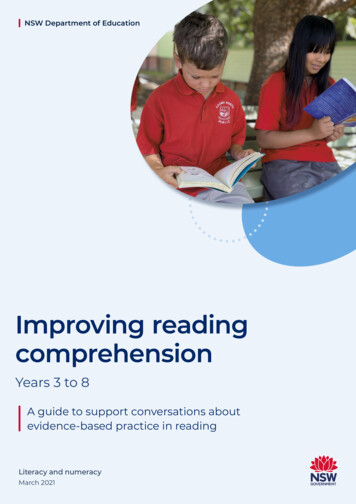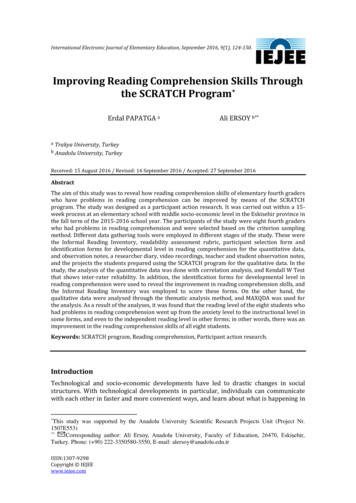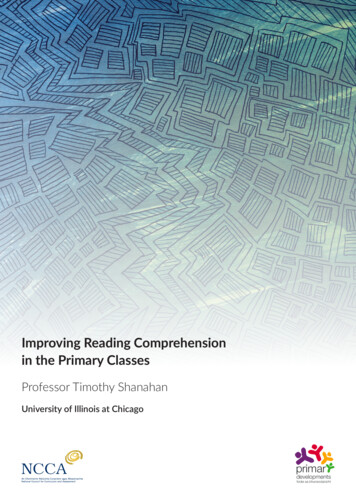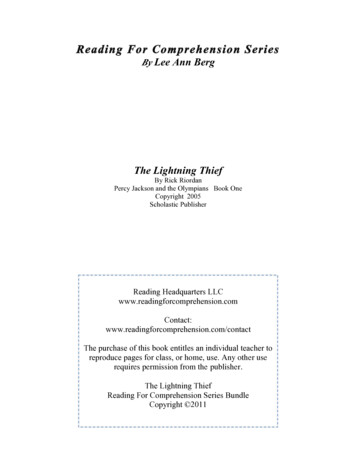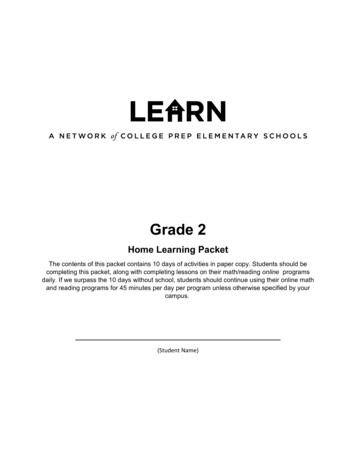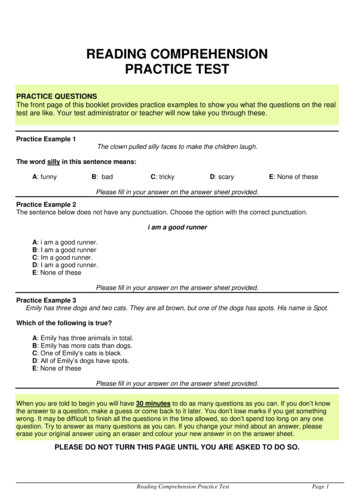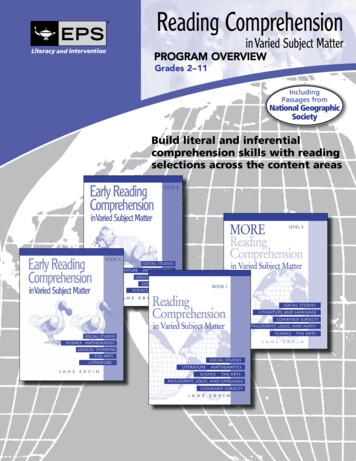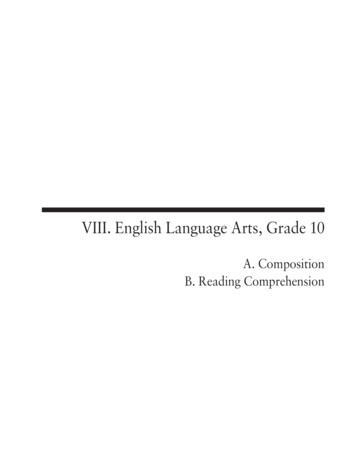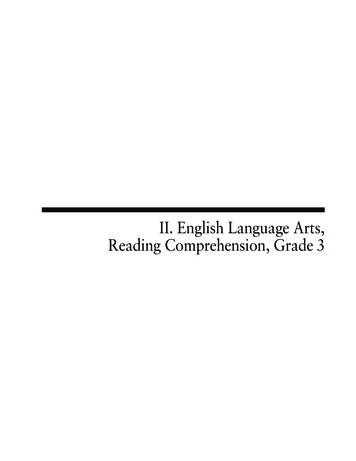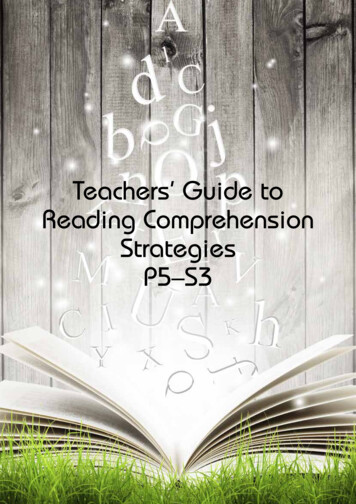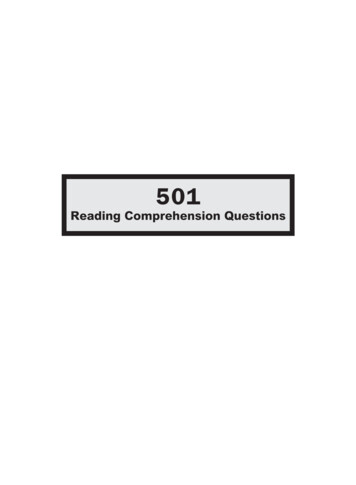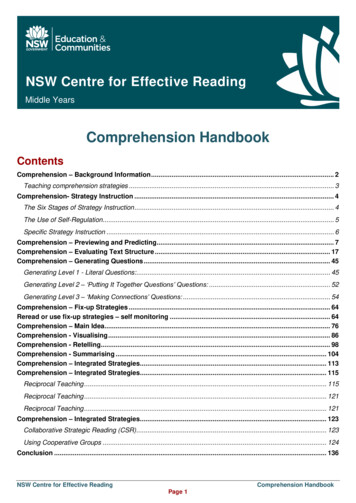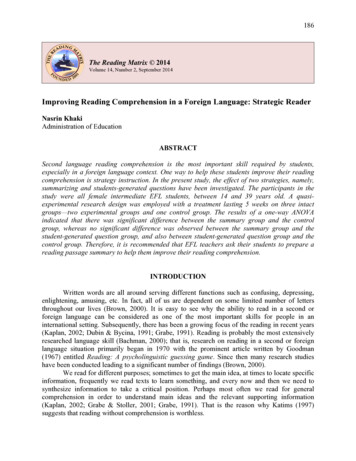
Transcription
186The Reading Matrix 2014Volume 14, Number 2, September 2014Improving Reading Comprehension in a Foreign Language: Strategic ReaderNasrin KhakiAdministration of EducationABSTRACTSecond language reading comprehension is the most important skill required by students,especially in a foreign language context. One way to help these students improve their readingcomprehension is strategy instruction. In the present study, the effect of two strategies, namely,summarizing and students-generated questions have been investigated. The participants in thestudy were all female intermediate EFL students, between 14 and 39 years old. A quasiexperimental research design was employed with a treatment lasting 5 weeks on three intactgroups—two experimental groups and one control group. The results of a one-way ANOVAindicated that there was significant difference between the summary group and the controlgroup, whereas no significant difference was observed between the summary group and thestudent-generated question group, and also between student-generated question group and thecontrol group. Therefore, it is recommended that EFL teachers ask their students to prepare areading passage summary to help them improve their reading comprehension.INTRODUCTIONWritten words are all around serving different functions such as confusing, depressing,enlightening, amusing, etc. In fact, all of us are dependent on some limited number of lettersthroughout our lives (Brown, 2000). It is easy to see why the ability to read in a second orforeign language can be considered as one of the most important skills for people in aninternational setting. Subsequently, there has been a growing focus of the reading in recent years(Kaplan, 2002; Dubin & Bycina, 1991; Grabe, 1991). Reading is probably the most extensivelyresearched language skill (Bachman, 2000); that is, research on reading in a second or foreignlanguage situation primarily began in 1970 with the prominent article written by Goodman(1967) entitled Reading: A psycholinguistic guessing game. Since then many research studieshave been conducted leading to a significant number of findings (Brown, 2000).We read for different purposes; sometimes to get the main idea, at times to locate specificinformation, frequently we read texts to learn something, and every now and then we need tosynthesize information to take a critical position. Perhaps most often we read for generalcomprehension in order to understand main ideas and the relevant supporting information(Kaplan, 2002; Grabe & Stoller, 2001; Grabe, 1991). That is the reason why Katims (1997)suggests that reading without comprehension is worthless.
187Reading experts such as Anderson and Pearson (1984) and Aebersold and Field (1997)argued that the best way to teach reading is through bottom-up methodology in which readingtakes place by matching sounds and letters. The students are taught to focus on languageknowledge, vocabulary, and structure of a passage while reading. Ferhan (1999) states that topdown processing is more effective (now known as a psycholinguistic theory about learning inwhich the prior knowledge of the reader was deemed to be very important). However, otherexperts such as Kintsch (2005), Eskey and Grabe (1988), and Grabe and Stoller (2002) proposedan interactive approach to reading involving both bottom-up and top-down processing.Proponents of this approach believe that based on the situation, the reader decides whichapproach is more beneficial. More specifically, if the required background knowledge about thetext is available to readers, they will benefit from a top-down approach. Conversely, if they donot have this subject area specific knowledge that is necessary to understand the passage, then abottom-up approach would be more helpful (Hedge, 2008; Harmer, 2001; Brown, 2000; Dubin &Bycina, 1991).More recently, however, approaches to the teaching of reading have focused on theimportance of acquiring those strategies that help students become strategic readers while copingwith difficult passages (Alderson, 2005). Researchers have discovered that successful L2learners use more learning strategies and utilize them more frequently than their less successfulclassmates; this strategy use has been shown to occur before, during, and after L2 tasks (Grabe &Stoller, 2001; Kaplan, 2002; Oxford, Cho, Leung, & Kim, 2004). Kaplan (2002) asserts that oneof the most important features of reading is that it is strategic, that is, while reading, the readerassesses whether he has achieved his purpose for reading or not. If not, he should adapt differentmonitoring activities, which is the hallmark of a good reader.It is, however, important to emphasize that input is different from intake and thestrategies that are taught are not exactly the ones students will employ. In addition to teachingstrategies, teachers should help them pay heed to what they are doing (Robinson, 2005). Sincereading comprehension is not an observable phenomenon, assessing one’s comprehension anddevelopment of the skill through the use of those strategies illustrating comprehension seemsimportant (Brown, 2000). Therefore, the responsibility of the teacher also changes and it is notsufficient only to teach the strategies, but equally practice and utilize them in every lessonpersistently to affect achievement. In fact, the ultimate goal is to develop strategic readers whocan employ these strategies automatically to improve their performance on comprehension andrecall tests (Farrel, 2001; Grabe & Stoller, 2001).The past three decades have witnessed a large body of second language research onlanguage learning strategies (see, for example, Anderson, 2003; Ehrman, Leaver, & Oxford,2003; Macaro, 2006; Lan & Oxford 2003; McDonough, 1999; MacIntyre, 1994; Purdie &Oliver, 1999; Yamamori, Isoda, Hiromori, & Oxford, 2003). While some of them have overtlysought to move the theoretical understanding of language learning strategies forward, they hadmore practical goals, that is, to investigate ways of empowering language learners to becomemore autonomous and successful in their learning. Overall, strategy specialists usually believethat learners with strategic knowledge of language learning become more efficient, creative, andflexible, thus they acquire a language more easily.Various definitions of strategy have been proposed up to now, but the following strategydefinitions are more in line with the present study. Weinstein, Husman, and Dierking (2000)define learning strategies as “any thoughts, behaviors, beliefs, or emotions that facilitate theacquisition, understanding, or later transfer of new knowledge and skills” (p. 727). Similarly,
188O’Malley and Chamot (1990) define learning strategies as “the special thoughts or behaviors thatindividuals use to help them comprehend, learn, or retain new information” (p. 1).Generally speaking, a strategic reader uses strategies such as previewing a text, scanning,skimming, predicting the upcoming information, summarizing, guessing the meaning of newwords, generating questions about the text, recognizing text organization, etc (Grabe & Stoller,2001). Brown and Palincsar (1984) have introduced four main reading strategies for explicit anddirect strategy instruction, including summarizing, questioning, predicting, and clarifying.However, two of the most useful strategies are those in which the student summarizes orallywhat he has read about a passage or answers questions about the passage (Brown, 2000; Ur,1996). Moreover, Alderson (2005) states that if students generate their own questions andsummarize the lesson, they will learn more effectively and improve their reading comprehension.Although reading has been scrutinized a lot by different experts, no magic formula to thegood efficient reading have yet been found (Ziahosseiny, 2009). Unfortunately, in Iran, thetypical reading classroom scenario is that the teacher first reads the passage and then, more oftenthan not, translates said passage to the mother tongue before asking students to answer thequestions related to the passage posed by the author. In fact, most of these students do not knowwhat the actual purpose of reading is. Subsequently, when they can translate the text literally,they think that they have comprehended the passage. Of course, as Kaplan (2002) argues, thistranslation technique can have a purpose in reading, but it is nonetheless a skill outside of thestandard reading purposes. In this study, the researcher focuses on two strategies: summarizingand generating questions while reading a text.LITRERATURE REVIEWGenerating QuestionsConventionally, students are instructed to focus on language knowledge, vocabulary, andthe structure of a passage while reading. However, since reading comprehension is an interactiveprocess, teachers can encourage learners to be active while reading a text. To help learnersbecome critical and strategic readers, teachers can encourage them to ask questions and find theanswers to the questions posed (Hedge, 2008). Traditionally, the questioner is the teacher and thestudent only provides the answer. That is why many students are not able to generate goodquestions. However, generating questions has been proven a helpful reading strategy andstudents should engage in such behaviors to ensure that they have read the text carefully(Hervey, 2006). Doing so leads them to a higher level of thinking and reflection upon their ownlearning (Chuck, 1995).Questioning, especially student-generated questions, is a useful strategy that improvesstudent reading comprehension. Based on Bloom’s taxonomy (Department of Education andSkill, 2005) questions can be posed at different levels—from knowledge to evaluation. There isevidence that engaging learners with generating their own questions leads to better learning(Hardy, Bates, Casey, Galloway, K. W., Galloway, K. R., Kay, Kirsop, & McQueen, 2014). Forexample, while some students at the elementary level could ask knowledge-based wh-questions(e.g., who, what, when, where), others could generate more challenging questions requiringhigher order thinking skills such as synthesis, application, or evaluation. However, students mayneed help to start generating their own set of questions. To pave the way, the teacher may
189support them by giving some guidelines (Nuttall, 1996). He or she could encourage them to workin small groups to check their understanding and to construct key questions. Then, the classcould select a set of appropriate questions to be answered by the students. Following constructivetraining, students could bring their own questions into the class and evaluate their collective levelof comprehension (Hedge, 2008).It is important to note here that generating questions is a strategy that can be done atdifferent phases of reading (pre-reading, while-reading, and post-reading) (Grabe & Stoller,2001). In the first phase, questions can provide students with a reason for reading, whereas in thewhile-reading phase, a guide-o-rama which can be in the form of a series of questions can leadstudents through the reading selection and indicate what information is important. Finally, in thepost-reading phase, students can answer the questions and then, working in small groups, verifytheir responses—a kind of self-assessment (Dubin & Bycina, 1991). Nuttall (1996) and King(1992) claim that finding answers to the questions relevant to a difficult text can help studentscomprehend the text more fully because students work at the text level and take part in theprocess of linking their prior knowledge to new information. If students are accustomed to selfgenerated questions, they will equally develop an awareness of their level of comprehension(King, 1992).SummarizingWhen teachers teach reading, they do not exclude the other skills. They do providevariation in teaching methods to enable students to read more efficiently. In fact, some activitiesmay well require the integration of two or more skills (Nuttall, 1996), and using integrated-skillinstruction can be paramount as students move to higher levels of language proficiency (Grabe,2001). Summary is one such strategy that integrates reading with writing or speaking (Nuttall,1996; Dubin & Bycina, 1991). Nuttall (1996) considers summarizing as an invaluable readingstrategy “which demands full understanding of the text” (p. 206). asserts Indeed, it is a kind ofcognitive strategy that helps students structure new input and show that they have understood thepassage (Oxford, 1990). In summarizing, students make a reduced, shorter version of the passagewherein the main ideas of the passage are included in the summary (Alderson, 2005). Forbeginners, it can be as simple as giving a title to the passage, even in L1. However, as thestudents advance in their language knowledge, summarizing can be made in L2 and students canwrite complete sentences or paragraphs (Oxford, 1990). Shih (1992) also calls for academic taskssuch as summarizing to help L2 learners get meaning from the text. She emphasizes that studentscan use this strategy to organize, reduce, and rehearse the significant information from the text soas to smooth the progress of recall.Thus, in the post-reading phase, the teacher could ask students to take notes and write asummary. As homework, students could be asked to provide a summary and then report saidsummary orally in the next class session (Dubin & Bycina, 1991). Overall, there is evidence thatsummary writing improves both reading and writing abilities (Grabe, 2001). In this context, it isworth pointing out that questioning is a bottom-up process, while summarizing tends to be moreof a top-down process. Summarizing can thus be more enjoyable for those students who aredaunted by an analytical bottom-up approach (Nuttall, 1996).
190Empirical Studies on Summarizing and Learner-Generated QuestionsIn both second and foreign language research, studies indicate that learning strategiesplay a considerable role in successful language learning. For instance, Riley and Lee (1996)pointed out that when readers were asked to write a summary of a passage rather than simplyrecall it, more main ideas were produced. Bensoussan and Kreindler (1990) compared the effectof summarizing and responding to short-answer questions on reading comprehensionimprovement. They trained one group of advanced students to summarize and the other group torespond to short-answer questions. Results indicate that there was no significant differencebetween the reading comprehension achievements of the students. On the other hand, Oded andWalters (2001) worked on the difference between students’ performance on readingcomprehension by assigning two tasks of writing a summary and listing the examples in the text.Findings indicate that students who did the summary task performed better on thecomprehension task. It also showed that summary writing would help students perform better oncomprehension tasks, and instead of considering it as a test method, it should be looked at as alearning instrument. Song (1998) also conducted research on the use of strategies, includingsummarizing, questioning, predicting, and clarifying in reading comprehension with first yearuniversity students in Korea. The findings indicate that these strategies could improve thereading development of students.Moreover, Yu’s (2008) research revealed that summarization promoted and betterpredicted reading comprehension abilities, especially if it was done in L1 (here Chinese). He alsofound low correlation between multiple-choice questions and summarization task. King (1992)conducted a study on college students who were divided into three groups: those who viewed alecture and took notes, those who generated their own questions about the lecture and, finally,those who wrote summaries of the lecture. In the immediate testing, the third group—thesummarizers—outperformed in recalling the lecture better than the other two groups, and theself-questioners, in turn, recalled the lecture content more than the note-takers. However, onanother retention test held one week later, the self-questioners performed better than the othertwo groups. It was concluded that for long-term retention, self-questioning may be a morepractical strategy than summarizing.There are also several studies conducted to find out the effect of student-generatedquestions on improving comprehension. For instance, Rosenshine, Meister, and Chapman (1996)concluded that teaching cognitive strategies such as generating questions helps students improvetheir comprehension. Furthermore, seeking to improve reading comprehension through storygrammar in which students read a paragraph aloud, found the main idea, and turned it into aquestion with a question word, Lubliner (2004) concluded that students who were instructed touse self-generated questions improved a lot at the end of the research period. Similarly, in astudy about student questioning, Taboada and Guthrie (2006) found out that students’ questionshad positive association with their reading comprehension.While many of the studies done to date relate to different aspects of reading and differentstrategies that can be used to improve students’ reading comprehension ability, nearly none ofthem directly compared the combined effect of the two strategies here investigated, namely,summary telling and student-generated questions on the reading comprehension ability of theintermediate EFL students. Moreover, most of these students used only summary writing, whilethis study intends to ask students to both write and tell the summary.
191Since English is a foreign language in Iran, reading is considered as the most importantskill. Therefore, English teachers are expected to become familiar with efficient strategiesdeemed important in reading. In the present study, summary telling and student-generatedquestions are selected because it is believed that summarizing a text is indeed a difficult processwhich needs a high level of processing that leads to better understanding and a richer memory ofthe text (McNamara & Kintsch, 1996; Kintsch, 1994). Furthermore, several availableexperiments indicate that instruction in generating questions has positive effects on readingcomprehension for elementary school, middle school, high school, and college students (King &Rosenshine, 1993; Nolte & Singer, 1985).Thus, the present study intends to find the effectiveness of these two types of strategies,namely, summary telling and student-generated questions on Iranian intermediate EFL students’performance in a reading comprehension test. These two strategies will be compared to ascertainthe most effective strategy. The study asks the following three questions:1. Does summary telling have any effect on students’ reading comprehensionperformance?2. Do student-generated questions have any effect on students’ reading comprehensionperformance?3. Is there a difference between the effect of summary telling and student-generatedquestions on students’ reading comprehension performance?METHODParticipantsThe participants of the study were 54 female, intermediate-level EFL students studying ina language institute in Iran. Based on a placement test, there were three intact groups (ages 1439). Participants were randomly assigned into two experimental groups and one control group.Of the two experimental groups, one group (n 19, ages 14-34) was assigned to study thepassages given to them, write a summary, and learn to be able to present it orally (summarygroup SG). The second group (n 19, ages 14-39) had to generate and write questions whilestudying the passage, and learn the passage so that they could answer questions posed by theteacher (student-generated question group SQG). Finally, the control group (n 15, ages 14-26)was assigned to study the passages and be prepared so that they could answer the teacher’squestions about the passages (control group CG).MaterialsSix short passages were selected, three of them were about famous people and the otherthree were on general subjects. Their length ranged between 156 and 232 words, and the FLeschReading Ease indices were ranging from 49.6 to 72.8. Then 23 multiple-choice questions wereprepared based on these six passages. Multiple-choice questions were applied to assess theimprovement of students’ comprehension; students could be assessed objectively for it was likelythat they understood the text without being able to express it in L2. A pilot study of the questionsindicated that the questions could discriminate between the better readers and the less skilledreaders. Thereafter, the questions were administered to a small sample of students to investigate
192whether they could answer the questions without having a text. They did not do well on the testand could only answer three or four random questions; as they revealed after the exam, it wasmostly by chance. However, the questions answered by most students were omitted. In the end,20 questions were selected. Ten more questions on general everyday subjects were also added tothe pre-test. Comprised of 30 questions—20 real questions and 10 false questions—the final testversion was employed both as pre-test and post-test.ProcedureNo general proficiency test was conducted because students were placed in intermediatelevel classes based on a placement test administered by the language center. In all, theexperiment was conducted in five sessions with a two-week interval between the first and thesecond session so that the questions in the pretest would not have any effect on the students’ textperformance. Classroom teachers were given detailed written directions before testadministration. In the first session, the pretest was conducted for all three classes with a 30minute allotted time. The procedure for each class was different and is explained below:1. Summary Group: This group was one of the two experimental groups tasked to studythe passages, write a summary, and be prepared for an oral presentation of the summaryfor the next session. In each session (sessions two, three, and four), they were given twopassages and were asked to prepare the summaries for the next session. They were alsoassigned to hand in the written summaries to the teacher in the next session; moreover,two or three of them presented their summaries orally in the classroom each session.2. Student-Generated Questions Group: This group was the second experimental group,and was tasked to study the passages, generate five questions for each passage, and beprepared to answer questions posed by the teacher in the next session. In each session(sessions two, three, and four), they were given two passages and were asked to writequestions for the next session. They were also assigned to hand in their written questionsto the teacher.3. Control Group: This group was assigned only to study the passages that were given tothem and be prepared to answer questions posed by the teacher in the next session. Ineach session (sessions two, three, and four), they were given two passages and wereasked to be ready for the next session.Finally, in the fifth session, a post-test was administered in all three classrooms and after30 minutes, all the papers were collected.Data AnalysisAfter conducting the experiment, the exam papers were marked. Each paper received 2marks, one for 20 major reading comprehension questions, and the other for the 10 general falsequestions. The data were then fed in the SPSS program version 18 for further investigation. First,since the number of participants in each group was less than thirty, the researchers made surethat the classes were samples derived from a normal distribution. Mean, mode, and median werethus calculated and it was observed that they were nearly the same. Moreover, a histogram of the
193post-test (mean 10.30, SD 3.93) indicated that the group could be considered as a sample fromnormal distribution. Thus, it was concluded that parametric inferential statistics could be appliedin this study.RESULTSThe first question this study explored focused on whether summary telling has any effecton students’ reading comprehension performance. Thus, a paired t-test was calculated (Table 1).As the result of the paired sample t-test shows, the t-observed value exceeds the t-critical valuefor 2-tailed tests at the .05 level of significance. Therefore, it can be concluded that there issignificant difference between the pre-test and post-test performance of the group assigned to tellsummaries with the mean difference of 9.473.Table 1. Paired Sample T-Test for SG PerformancePair 1 10.80918t-critical1.734Sig. (2-tailed).000In order to probe the second research question dealing with the possible effect of studentgenerated questions on students’ reading comprehension performance, the mean score of the pretest and post-test of the second group was compared through a paired sample t-test (Table 2).Results indicate that the mean score of pre-test and post-test differ a lot (mean 7.315) and the tobserved value (9.761) exceeds the t-critical value (1.734) for 2-tailed tests at the .05 level ofsignificance. Therefore, there is significant difference between the pre-test and post-testperformance of the group assigned to generate questions.Table 2. Paired Sample T-Test for SQG PerformancePair 1 153.266.7499.761181.734Sig. (2-tailed).000Another paired sample t-test was also conducted to find any difference between the meanvalue of the pre-test and post-test of the control group (Table 3). As shown, there is a significantdifference between the mean score of pre-test and post-test (mean 5) and the t-observed value(6.847) goes beyond the t-critical value (1.753) for 2-tailed tests at the .05 level of significance.Table 3. Paired Sample T-Test for CG PerformancePair 1 pretestposttestmeanSDSEMt-observeddft-criticalSig. (2-tailed)-52.921.7306.847151.753.000To answer the third research question, which examined the existing difference betweenthe effect of summary telling and student-generated questions on students’ readingcomprehension performance, a one-way ANOVA was calculated (Table 4).
194Table 4. One-Way ANOVA for the Three Groups’ Post-Test PerformanceSum of Squares238.417df2Mean Square119.209Within Groups582.8425111.428Total821.25953Between GroupsF10.431Sig. (2-tailed).000As the results indicate, the F ratio (10.431) for the means of the three groups proved to besignificant at the .05 level. Thus, a post hoc Scheffe test was applied to investigate where thedifference lies (Table 5).Table 5. Scheffe Test Result for One-Way ANOVA for the Three GroupsMean DifferenceStandard ErrorSigSG — SQGSQG — CG2.5262.7101.0961.147.080.071CG — SG-5.2361.147.000Note. SG: summary group, SQG: student-generated question group, CG: control group.As the calculations indicate, there is significant difference between SG and CG, but thereis no significant difference between SQG and CG, or between SG and SQG. To make sure thethree groups were the same level of performance in the pretest and that the difference in the posttest performance was not because of their different performance in the pretest, a one-wayANOVA test was conducted (Table 6).Table 6. One-Way ANOVA for the Three Groups’ Pre-Test PerformanceBetween GroupsWithin GroupsTotalSum of Squares5.06389.47494.537df25153Mean Square2.5321.754F1.443Sig. (2-tailed).246Again, as the results indicate, the F ratio (1.443) for the means of the three groupsconfirmed the fact that at the .05 level of confidence, there is no significant difference betweenthe groups; that is, the three groups performed equally in the pretest.DISCUSSIONThe main purpose of this study was to investigate the effectiveness of two cognitivereading strategies, namely, summary telling and student-generated questions on Iranianintermediate EFL students’ performance in a reading comprehension test. Choo, Eng and Ahmad(2011) emphasize that strategy instruction is effective. Their students were involved in theprocess working together by asking questions, summarizing, predicting, and clarifying.
195According to the study conducted by Carrel (1992) on the awareness of text structure, there wasevidence that finding relations between ideas and between main ideas and details can help L2readers recall the text better. It is, therefore, assumed that summarizing involves finding therelations between the main idea and the supporting ideas in the text. This may be because insummarizing a text, learners work back and forth between the text, the paper they are writing,and the requirements of the assignment (i.e., rereading, rewriting, and continually reflect on andcompare aspects of these elements). Thus, the summary group was expected to outperform theother two groups in the post-test.As the results of the calculations indicate, all three groups improved in their post-test;however, we should consider that while administering the pre-test, the participants had notstudied the reading passages, and the main purpose of administering the pre-test was to makesure that students could not answer the main questions without studying the texts as these textswere new to them. Thus, this researcher expected a significant difference between theirperformance in pre- and post-test.The one-way ANOVA and Scheffe results for post-test demonstrated that there was asignificant difference between the summary group and the control group due to the fact that theformer had to study the passages with great involvement and attention which, in turn, provided adeep level of understanding. However, the findings indicate that the difference between thesummary group and student-generated question group, and the difference between studentgenerated question group and the control group was not significant. Yet, considering the meanvalues of these three groups in
Improving Reading Comprehension in a Foreign Language: Strategic Reader Nasrin Khaki Administration of Education . higher order thinking skills such as synthesis, application, or evaluation. However, students may need help to start generating the
